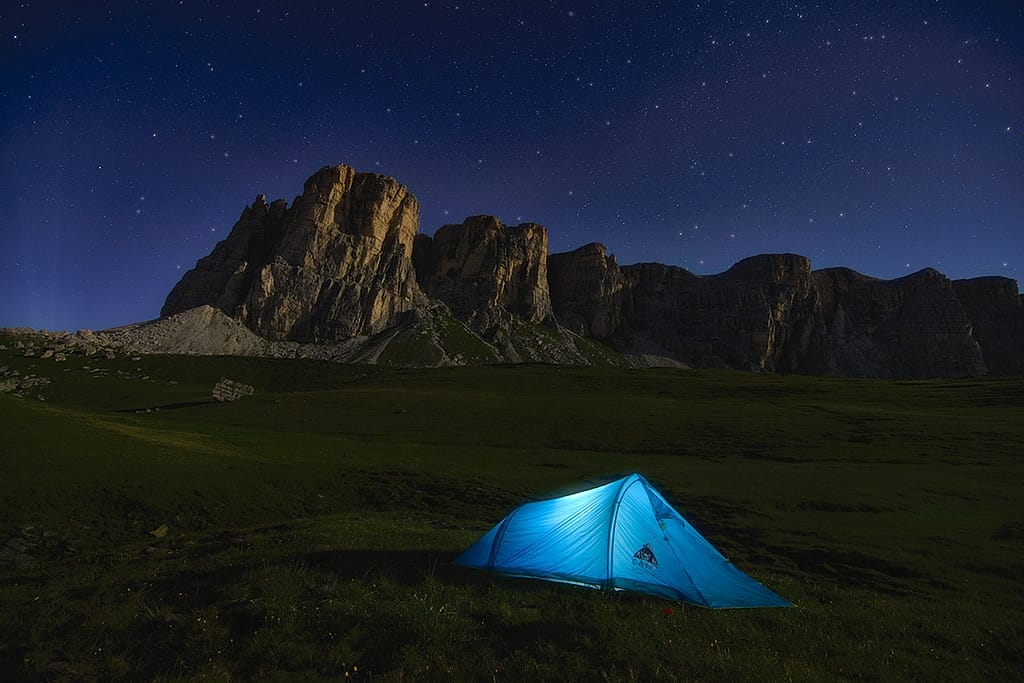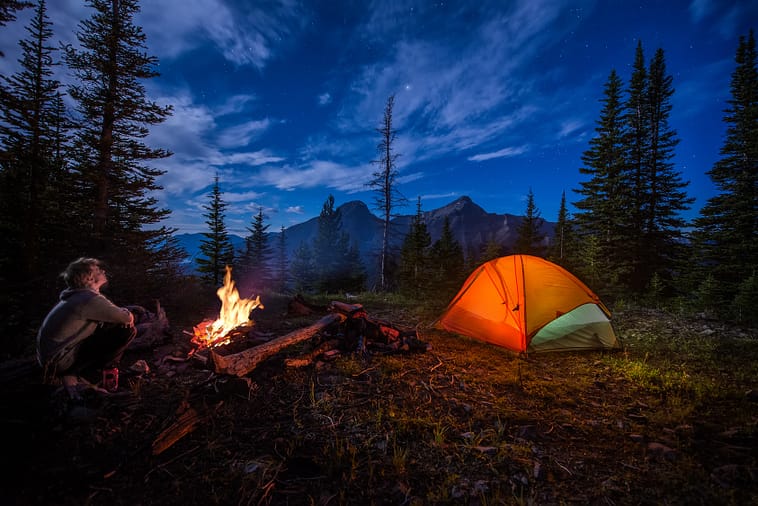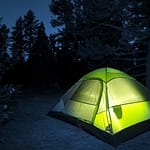Having a great campfire will not only keep everybody warm but it is also great for morale. People have evolved around fire and there is a deep evolutionary trait inside each one of us which makes us feel good when sitting next to a fireplace and staring at the burning wood. Campfires can be either easy to make or extremely hard, depending on the conditions in which you try to light them up. Keeping the campfire burning, on the other hand, is almost always a hard task even for experienced hikers. This is why we made this article in which we will show you the principles of fire burning, and how to understand your fireplace better, in order to keep it from simmering down.
Key Takeaway: Be prepared and have a plan. Scope out the right location, gather enough wood for the duration of the night, and choose a good starter. If you’ve never built a fire before, practice before your camping trip. While it may look easy enough, there’s a little finesse involved when it comes to creating a fire and keeping it going. The biggest mistake beginners often make is smothering a fire and not carefully building it up. We’ve got some great tips you can follow that will teach you how to properly build and fuel a campfire, so you can keep your fire going all night long, easily.
Continue reading to check out our top tips that will help you build the perfect campfire.
The Three Things That Keep A Campfire Burning
Before we move on, let’s take a brief look at the anatomy of a campfire
Any burning substance needs three factors to keep on burning. Those are:
- Heat
- Oxygen
- Fuel
If any of these three is absent, the fire will quickly go out. If you smother your campfire, it will go out. If you stop adding fuel to your campfire it will stop burning. If your campfire gets soaked wet or lacks appropriate fuel for sub-zero temperatures, it will go out. It is that simple. Always follow these three principals and you will never experience a fire that gasses out on you. Build your campfire in the open, where it will have enough oxygen, keep adding wood to it and it will reward you with a constant rate of burning.
Want to know which are the best burning woods out there? Check out our article on the topic.
Now, let’s take a look at the process involved in making a great campfire which will keep on burning all night.
Choosing The Right Location And Creating Your Campfire Bed

Building a nice fire begins with finding the perfect spot for it. In a perfect scenario, you should make your campfire in a location which won’t get wet during rain such as the base of an overhanging right. The ground beneath your fire should be dry or at least semi-dried out.
If you are camping in a wildlife refuge or a state park, you will need to make your fire inside the existing fire rings there. If you can’t find a dry spot, create a cover over the fire before lighting it up. Use branches and wood for the cover and tie them up in a structural way. Just remember that it has to be high enough in order to not catch flame.
Your next step is creating the fire bed. In this process, always think about safety. After all, you don’t want to be that guy who’s being shown on TV that started a wildfire. Select a proper site away from nearby trees, bushes or other flammable material. The fire bed should be on dry earth and in no case over grass (both fresh or dry). If you can’t find a bare area on the ground, dig a small hole and remove all the vegetation from the patch of ground you’ve chosen. After you’ve found/made the perfect spot, it’s time to make the actual fire bed. Gather dirt and create a platform in the center of your designated fire area. The platform should be a couple of inches thick. Add a few big stones if there are some around. If not, it is okay either way.
Your final step is to actually start the fire. This can be a near impossible task in rainy conditions but if it’s dry and warm it isn’t too much of a hassle. You need to get two things: tinder and kindling. Those are small bits of wood, paper, or wood crusts that can get your fire going instantaneously. Small sticks can usually be found in the base of trees in small piles. Gather as many as you can as they are quick fuel for any fire. Even if your fire starts dying out in the later stages, you can use some of the tinder you’ve gathered to “revive” it.
Pro Tip: newspapers and toilet paper are one of the best starting materials for a fire. They burn really well but also really fast. Dry leaves, birch bark, and other dry parts of trees are also ideal.
You need to remember that starting a fire is a cycle. It starts with tinder, goes through kindling and ends up with solid woods put into it. To keep the fire going you will have to repeat this process on a regular basis.
The more dry fuel you got stored away, the less likely it is that your fire will simmer down during more moist or cold conditions. Tree bark from birch trees contains oils that repel moisture and will burn even when moist, so it makes an excellent fuel for your fire for any sort of conditions.
Building A Fire that will Last the Night
When you’ve finally managed to build a beautiful fire for your campsite, if it ends up fizzling out at some point while you’re sleeping it can feel pretty defeating. Some seasoned campers recommend getting up in the middle of the night to stoke the fire, but if it’s freezing out, the last thing you’re going to want to do is leave the warm comfort of your tent or sleeping bag.
Fortunately, there are a few things you can do to ensure your fire burns slowly and lasts until the morning. This way, you’ll avoid having to build another fire as soon as you get up, plus you and your fellow campers will stay much warmer during the night.
So, how can you determine how much wood to put on your fire before you turn in for the night in order to prevent your fire from going out?
Every camping enthusiast is familiar with the half inch rule. Basically, half an inch of wood equals an hour of burning time. This means if you have a ten inch piece of wood your campfire will burn for ten hours. However, the burn time can also depend on the type of wood you use since some types of wood tend to burn faster than others.
The following wood is slow-burning and the best type of wood to use for your next campfire:
- Ash
- Oak
- Maple
- Cherry
- Birch
- Beech
Choosing the right type and right sized piece of wood can ensure your fire burns all night long.
Want to find out which are the best camping cots for this season? Check out our full Buyer’s Guide!
Some Handy Tips for Your Next Campfire
- Make sure the campfire is well ventilated (best case scenario is from all sides). Blow on your fire especially when starting it. This will raise the temperature and clear out all the ashes gathered from already burned kindling between the logs.
- To restart a burned out campfire, gather all the embers into a pile. Stack tinder and kindling on top of that pile and whenever you see a flame rising, start adding wood again. Softwood is ideal for this scenario.
- Contrary to what people say, huge logs aren’t best for your fireplace. If the log is too big it will take a long time for it to catch fire and this can be fatal for the remainder of the campfire. Keep your eyes open for branches and sticks that are as wide as your wrist or forearm (for women).
- Rocks are commonly placed inside a fire since they’re able to retain heat well and can help keep your fire burning for an extra hour or two.
- Placing ash over your burning fire is another trick many seasoned campers use to keep their fire going for hours. Doing so will make the wood burn at a much slower rate. This is a neat trick and one that will come in handy if you want to avoid building another fire in the morning or you’re running short on your wood supply.
- As we mentioned, the more moisture there is in your fire, the harder it will be to maintain it. Keep the wood as dry as possible if you don’t want to end up with a pile of smoking sticks. Recently cut down trees are rich on water and do not burn well.
- For the final stage of the fire, look around for oak and birch trees. They are nice hardwoods which burn hot and last long, ultimately creating a well-sustained campfire.





